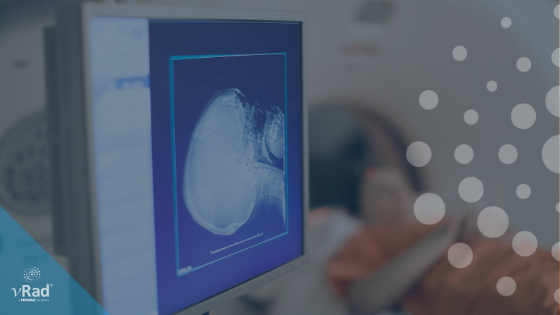Beyond Theory: Building on the Success of Radiology AI
For the latest information on vRad’s Artificial Intelligence program please visit vrad.com/radiology-services/radiology-ai/ Our AI models are at work...

Remote radiologist jobs with flexible schedules, equitable pay, and the most advanced reading platform. Discover teleradiology at vRad.

Radiologist well-being matters. Explore how vRad takes action to prevent burnout with expert-led, confidential support through our partnership with VITAL WorkLife. Helping radiologists thrive.

Visit the vRad Blog for radiologist experiences at vRad, career resources, and more.

vRad provides radiology residents and fellows free radiology education resources for ABR boards, noon lectures, and CME.

Teleradiology services leader since 2001. See how vRad AI is helping deliver faster, higher-quality care for 50,000+ critical patients each year.

Subspecialist care for the women in your community. 48-hour screenings. 1-hour diagnostics. Comprehensive compliance and inspection support.

vRad’s stroke protocol auto-assigns stroke cases to the top of all available radiologists’ worklists, with requirements to be read next.

vRad’s unique teleradiology workflow for trauma studies delivers consistently fast turnaround times—even during periods of high volume.

vRad’s Operations Center is the central hub that ensures imaging studies and communications are handled efficiently and swiftly.

vRad is delivering faster radiology turnaround times for 40,000+ critical patients annually, using four unique strategies, including AI.
.jpg?width=1024&height=576&name=vRad-High-Quality-Patient-Care-1024x576%20(1).jpg)
vRad is developing and using AI to improve radiology quality assurance and reduce medical malpractice risk.

Now you can power your practice with the same fully integrated technology and support ecosystem we use. The vRad Platform.

Since developing and launching our first model in 2015, vRad has been at the forefront of AI in radiology.

Since 2010, vRad Radiology Education has provided high-quality radiology CME. Open to all radiologists, these 15-minute online modules are a convenient way to stay up to date on practical radiology topics.

Join vRad’s annual spring CME conference featuring top speakers and practical radiology topics.

vRad provides radiology residents and fellows free radiology education resources for ABR boards, noon lectures, and CME.

Academically oriented radiologists love practicing at vRad too. Check out the research published by vRad radiologists and team members.

Learn how vRad revolutionized radiology and has been at the forefront of innovation since 2001.

%20(2).jpg?width=1008&height=755&name=Copy%20of%20Mega%20Nav%20Images%202025%20(1008%20x%20755%20px)%20(2).jpg)

Visit the vRad blog for radiologist experiences at vRad, career resources, and more.


Explore our practice’s reading platform, breast imaging program, AI, and more. Plus, hear from vRad radiologists about what it’s like to practice at vRad.

Ready to be part of something meaningful? Explore team member careers at vRad.

The DAWN Trials, among others, support positive results for stroke patients who first receive treatment up to 24 hours after symptom onset. Current guidelines that require treatment within 6 hours or less limit clinicians’ treatment options for stroke patients when initial signs may have gone unobserved, or when the patient may have been delayed in getting to the ER. Emerging guidelines are opening a much larger window of opportunity through which we can properly diagnose and treat stroke victims.
The 200% increase in night and early-morning CT Perfusion studies our practice is reading this year is a clear indication that both rural and urban facilities are seizing this opportunity to significantly elevate their level of stroke patient care.
After declines from 2000 through 2013, the death rate due to stroke has been slowly increasing since 2014, according to the CDC.
Recent clinical guidelines require diagnostic confirmation of stroke within 4.5 hours of first signs to initiate IV tPA, and within 6 hours to initiate mechanical thrombectomy procedures. But the moment of onset is often difficult to pinpoint.
An estimated 25% of strokes are classified as wake-up or daytime-unobserved strokes. That means for roughly 200,000 of 800,000 U.S. stroke victims annually, it is virtually impossible to determine symptom onset within a 6-hour – let alone 4.5-hour – timeframe. However, the vast majority of these can likely be determined as having begun within a 24-hour period. Which raises the question: What are the best treatment options for stroke victims whose onset falls in the 6- to 24-hour range?
We are in the middle of some of the most significant changes in stroke management in the last 20 years, with the potential to reverse growing mortality rates, while significantly reducing long-term morbidity for stroke survivors.
We are beginning to see exciting results from a number of trials that began around 2015. The DAWN Trial is among them. (DAWN is shorthand for diffusion weighted imaging or computerized tomography perfusion assessment with clinical mismatch in the triage of wake up and late presenting strokes undergoing neurointervention with Trevo.)
The DAWN Trials support that, among patients with acute stroke who had last been known to be well 6 to 24 hours earlier and who had a mismatch between clinical deficit and infarct, outcomes for disability at 90 days were better with thrombectomy plus standard care than with standard care alone.
Based on these trials, clinicians now know that patients with wake-up strokes, strokes with unclear onset time, and witnessed late presenting strokes may potentially benefit from intra-arterial reperfusion therapy.
Radiology will play a vital role in this evolving approach. An important indicator of whether subjects will benefit or not during this later time window is the confirmation of a large vessel occlusion (LVO), and assessment of the core infarct volume relative to the volume of salvageable penumbra.
Working with their imaging partners, clinicians now have treatment protocols they can follow to help these patients.
Swift response in stroke cases remains critical. Regardless of whether onset is determined to have been 20 minutes prior or potentially 20 hours prior, the clock is still ticking. Each minute that passes without treatment increases the risk of further brain damage – potentially resulting in more severe long-term disability while reducing a patient’s chances of survival.
The exciting news is, we now know the clock doesn’t stop after 6 hours.
A non-contrast head CT is still the fastest way to reliably confirm cerebrovascular disease and provide clinicians the information they need to deliver suitable emergency treatment.
Radiologists should see a lot more head CTs and cerebral perfusion studies as hospitals extend care protocols to include the 6- to 24-hour stroke victims. The vRad team of over 75 neuroradiologists is on pace to read over 3,000 perfusion studies in 2018 – a 200% increase over 2017.
It is still essential that each head CT is read promptly by a qualified specialist, with an accurate diagnosis delivered quickly to the clinician. vRad stroke protocols enable our teleradiology professionals to respond, on average, in under 7 minutes to ordering physicians anywhere in the country at any time of day or night.
DAWN and other trials support new guidelines that promise better outcomes for hundreds of stroke victims every day. Core to the success of these standards will be fast, accurate diagnostic imaging assessments and reporting.
Learn More About Stroke Imaging Success in the New DAWN Paradigm
Back to Blog.png)
For the latest information on vRad’s Artificial Intelligence program please visit vrad.com/radiology-services/radiology-ai/ Our AI models are at work...

A growing number of health organizations are making computed tomographic perfusion (CTP) a critical part of their stroke intervention protocols.

As I mentioned in my last post, May is both Trauma and Stroke Awareness month. vRad serves hundreds of trauma and stroke centers across the U.S. The...
vRad (Virtual Radiologic) is a national radiology practice combining clinical excellence with cutting-edge technology development. Each year, we bring exceptional radiology care to millions of patients and empower healthcare providers with technology-driven solutions.
Non-Clinical Inquiries (Total Free):
800.737.0610
Outside U.S.:
011.1.952.595.1111
3600 Minnesota Drive, Suite 800
Edina, MN 55435